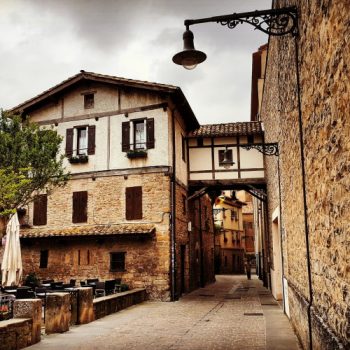
What You Need to Know about Santiago de Compostela
Santiago de Compostela, Galicia
 Transport options to arrive: Train, Plane, Bus, or Car
Transport options to arrive: Train, Plane, Bus, or Car
As always, I recommend using omio.com to compare prices as the availability, cost, and time-efficiency of each of the above options will vary greatly depending on where you are traveling from. Don’t forget that “car” doesn’t mean you have to drive yourself—consider sharing the ride by posting your trip or searching for a driver to travel with on Bla Bla Car!
Recommended time of year to visit and length of visit: Year-round, 2 or 3 days. The temperatures in Santiago stay relatively mild year-round, with June-September being the driest and warmest months (still only averaging around 24˚C/75˚F) so the summer may be the best time for taking in the city in the sunshine.
Fun Fact: Santiago de Compostela is named after Saint James (‘Santiago’ in Spanish), with speculation over the ‘de Compostela’ part originating from the Latin for “field of the star” or “burial ground.” Both would make sense as the city is the end point of the 500 mile-long Camino de Santiago pilgrimage route, which historically required one to follow the stars towards the west, as well as the burial place of Saint James (one of the twelve apostles recognized by the Christian religion).
Top three must-sees:
 1. Catedral de Santiago: The Cathedral of Santiago was built upon the land where Saint James’ remains were discovered and serves as the final destination for the Camino de Santiago. It’s a beautiful cathedral in its own rite, but there is something especially powerful about visiting this one as you can wait in line to “embrace the apostle” (aka see, hug, kiss, or whatever you feel appropriate with the golden bust of Santiago). It may seem silly to you, as an average tourist. However, seeing those who have walked hundreds of miles on the Camino de Santiago in order to reach this moment, often overcome with emotion, is something you won’t soon forget.
1. Catedral de Santiago: The Cathedral of Santiago was built upon the land where Saint James’ remains were discovered and serves as the final destination for the Camino de Santiago. It’s a beautiful cathedral in its own rite, but there is something especially powerful about visiting this one as you can wait in line to “embrace the apostle” (aka see, hug, kiss, or whatever you feel appropriate with the golden bust of Santiago). It may seem silly to you, as an average tourist. However, seeing those who have walked hundreds of miles on the Camino de Santiago in order to reach this moment, often overcome with emotion, is something you won’t soon forget.
2. Parque Alameda and Las Dos Marías: This is a beautiful green space to saunter through and take in some fresh air. Perfect for a low-cost picnic lunch that you brought along or for relaxing after a fancy meal eaten out.* Don’t forget to snap a photo with Las Dos Marías, a statue depicting the Fandiño Ricart sisters—local celebrities as they became known for getting all dolled up to take a stroll through this part of town each day at exactly 2pm in order to check out and flirt with the university students.
 3. Parque de Bonaval: While there are plenty other important landmarks, historic buildings, and museums we could include in in our Top Three, I’m going to let you in on this lesser-known treasure that our Couchsurfing host shared with us. Bonaval might not be as beautiful as other parks you have visited, but it was built upon an old cemetery and is full of enchantment. Take some time to discover its nooks and crannies or simply sit and take in the tranquility. Highly recommended for artists, photographers, or writers looking for a different perspective of Santiago.
3. Parque de Bonaval: While there are plenty other important landmarks, historic buildings, and museums we could include in in our Top Three, I’m going to let you in on this lesser-known treasure that our Couchsurfing host shared with us. Bonaval might not be as beautiful as other parks you have visited, but it was built upon an old cemetery and is full of enchantment. Take some time to discover its nooks and crannies or simply sit and take in the tranquility. Highly recommended for artists, photographers, or writers looking for a different perspective of Santiago.
One thing to eat: Pimientos de Padrón
This simple Galician dish is simply delicious! Small green padrón peppers (native to Galicia) are picked when they are still small, seared in olive oil, and served alone in a large pile. Not yet intrigued? Your American taste buds are sure to perk up for this part—although most of the peppers will be mild, every now and then you will come across a spicy one and there is no way to predict it! Hot pepper roulette…let the games begin!
*Have the two suggestions got you pondering your preferred travel style? Be sure to check out our article on that, too!




